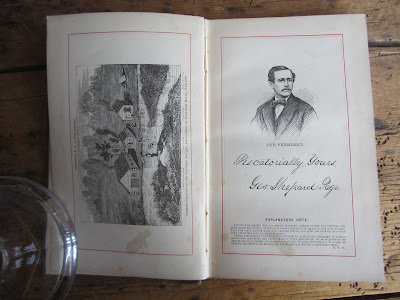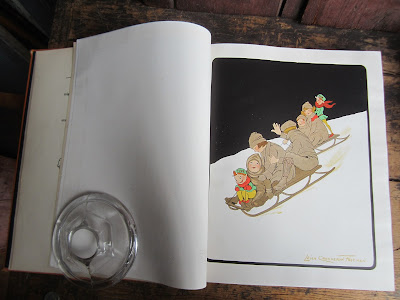Rare Book Valuation
How I Do That
Part Five
"Wait A Minute"
It
would seem I could wrap things up?
I’ve assembled the components for a formula projecting a
‘valuation’. Haven’t I? IF... one copy is for sale on eBay for
$575.00 and a second copy was at auction estimated a $1500. – $2500 but did not
sell and a third copy actually sold at auction for $2128.00 and I cannot find
any other actual copies of the actual original first edition of the actual old
book BUT TOO... notice is noted that a ‘fish print’ is in the book with, too, a
menu... whatever that’s about... and... apparently... numerous “nice old”
(original to the original book) illustrations all within an attractive 1869
‘publisher’s cloth with title in gilt gold’ original binding and... notice is
noted too to... PAY ATTENTION TO THE condition OF THE BOOK and... THE condition
OF MY COPY of the book and, of course, I never forget ‘divide by four’ (Part
Three).
The
formula is actually suggesting we need to do a bit more... rare book seller...
work... “before we get there” (have a valuation that ...SELLS the book. A couple of dibs and dabs of “Wait a
minute”).
Oh...
your just gonna keep your copy “anyway”?
No your not. Why? Because you do not have a copy of this
book. Why? Because this book is ...in actual
fact.... a RARE BOOK. You’s gonna
be rare book hunter along time before you “FIND” a copy of Allerton... ‘on the
loose’ that you may choose to “keep”.
All rare book hunters will tell you that one will find a ‘rare book’ but
it probably won’t be the old rare book you aspire to ‘keep’. Anyway and again, the old rare books I
find I aspire TO SELL... You can
...and may... “buy mine”?
So
I go back over the ‘its’ again. Let me start with the eBay copy. I remember reading the condition
description ‘very carefully’ (Part Four).
I read it again. SURE
ENOUGH what I recalled reading is still reading the same: At $575.00 this eBay copy for sale
notices in minimal text that this copy lacks (is missing) the folding fish
print. An imperfect copy... to say
the least. “The least?” Yeah... every info bit I’ve found on
the Allerton notices the beautiful fish print of a Brook Trout. So... like... if... YOUR copy lacks
this plate... your copy of this old rare book (Allerton) IS an imperfect copy
missing the most featured item and what does that mean for valuation to
collectors? IT MEANS “NO”. Would you buy a car without its
engine? “NO”. Got it? It is “NO” no matter what. Collectors do not want an Allerton missing the fish
print. Not even for a ‘divide by
four’ $125.00. It is... to a rare
book hunter/seller like I... a... “NO!”.
No matter what including it now being obvious why this copy of Allerton
is still sitting around on eBay “at five seventy-five”.
My
copy has the fish print in PERFECT CONDITION. It has to have the fish print and I want it to be ‘perfect
condition’ too... for a ...collector grade... valuation. And, again, I know you ‘don’t have one’
(a copy).
Skipping
over the old ‘unsold’ auction listing because it is vague in its details and
I... have the ...very detailed (including the fish print) descriptions (note
plural) and illustrated... Thompson Sale catalog listing... I... very carefully
purposely slowly patiently and with my actual copy at ...and in... hand I...
yeah I even have a magnify glass too for that is so ‘tweed jacket mustachioed
pipe smoking old school rare book seller...
Here
within that catalog entry are all the noted tid-bits I need to know of and find
ALL of the features of a collector grade copy... including the menu... and
“Condition”
This
last I’ll get back to as a stand alone valuation issue. Right now I spend my time ‘checking
out’ the proper completeness of my copy “compared to Thompson (the Thompson
copy)”. It (my copy) does compare
‘complete as issued’ so mine (my copy) may be ‘seller offered’ as ‘being
identical to the Thompson copy’, a seller to collector assurance that is
VERY... GOOD to be able to amend to MY COPY. This sort of full bore comparison quickly makes ‘good sense’
to any full bore rare book hunter because it makes... good cents... too.
Let
me make a strong suggestion at this moment: READ THE BOOK. Reminding
again that all of this rare book realm is about books and reading... why not
now that one has actually purloined to be at hand an actual rare book... READ
IT? Question mark. Before that... task... one must accept,
acknowledge and ...actually do...; inspect the ‘your rare book’ PAGE by PAGE to
be, well, at a ‘least’, sure that ALL of the book is... ahhhh.... “There”. This is called ‘collating it’ and means
that, as an owner/seller.... YOU have looked at (INSPECTED) every page ‘to be
sure’ “MY COPY” is “all there”.
The way this ends in rare book seller land is a purchasing collector
will ask... ME... “did you (I) collate it?”
“Yes.” That’s a barrelhead top guarantee that
the book is ‘all there’. It is
never mentioned again... in professional settings. Now... on the wait a minute... a collation “done by you” is
considered worthless and a “I have to do that myself (before I’d buy the crummy
rare book you found) Nothing
personal: Just a professional
‘must’ and you ‘can’t be trusted at that’ (collation of anything).
While
I am looking at each page... the suggestion of actually reading the book is
denoted and as this rare book... like so many rare books, has a ‘very thin’
amount of text, the... to actually read the book is NOT difficult to do. Actually it is most often FUN to
do. For example... a first edition
of Robert Burns’ first book of poetry... is a rare book that is too a (actually
not that) thin book so if one has one of those, likes Burns and likes all the
rare book banter about Burns too... to actually read, yourself, the actual
first edition copy of this “your rare book I found”... IS FUN. Unless you are a really greedy rare
book seller who feels this is all about money and not about reading books
and... in most cases... these types cannot read ‘anyway’.
Stepping
back a moment here I call attention to the ‘very thin’ above. The economics of the first edition –
first book... at the moment of creation commonly was done with very small
budget so... to no surprise a great many ‘rare books’ were published (and self
published) on very skimpy budgets so that the resulting rare book today is very
often a very thin rare book.
That’s a hint for you: Many,
many true rare books are truly thin books too. It is okay to not embrace this hint because you’ll ‘find out
anyway’ if you ever go anywhere ‘in rare books’. When I look at the spine ends on your book case... I am
looking for very thin spine ends.
The more thin books I see, PROBABLY the better collection “I am looking
at” and... I have not even touched the ‘your books’ yet. I won’t be touching your books ...if
they are too thick. But, of
course, this has nothing to do with rare book valuation. Or does it?
The
Allerton... IS a thin book. To no
surprise to me. So as I am
...reading it... (a possible two thousand dollar book I own and will be
selling)... I am looking at ALL the details that ‘make’ up the book. “Make up the book” is not ‘valuation’
of the book. Make ups are
different critters than value. I
will note some ‘make ups’ in the Allerton but I will not explain them:
Cover
with title in gold
Spine
end.
Title
page
Preliminaries
Imprint
Published
(here published by the author}
And
‘sold’ by the author
WHERE
(New York)
Dates
(of occurrence and publication)
Copyright
Full
page prints
Printed
textual illustrations
The
text; titles and subtitles
The
fish print
The
menu
Additional
leaves (pages) of ‘advertising at the end
Rear
cover blind stamped with title.
And
more.
While
I am reading the book (Allerton) I am also very carefully ‘looking at every
page’. Just for me. “This is fun”. Remember Rat and Mole: ‘Nothing is so
much fun as messing around with...’ Old Books. If one is not a ‘totally there’ with this old books –
reading them... the ‘I want to be a rare book hunter’ and ‘make a lot of money
doing that’ is going to have a perpetual crass or trashy taint to your actions
with it (old rare books) and... the most professional ones (rare book people)
WILL quickly note this ...without noting it to you... and... then you will be
professionally qualified ‘evermore’.
Let
us touch this point. I do not ever
talk about any of this... to anyone... for any reason. That I am a rare book seller prowling
to purloin the finest rare books I may find... is never spoken of or shown...
off. No. Never. You’d
never know. Never ever know. A playing dumb is the least of it. I prefer to play ‘not even there’. Most rare books I find are found by I
in the hands of a great ‘don’t know’ and I assuredly follow through by making sure
their transactions with me never ever suggests in anyway that an ‘old’ ish book
is ever in anyway a true old rare book ‘I found’ and “valuable’. And: If you are a rare book hunter I prefer that YOU feel that I
‘don’t know’. ANYTHING.






































































